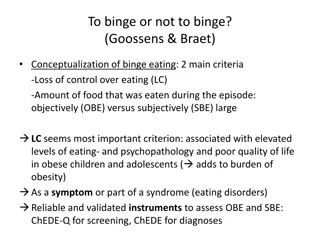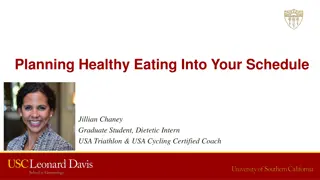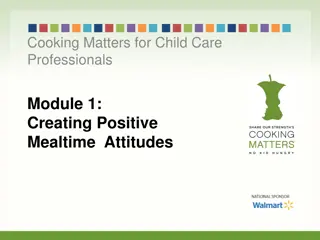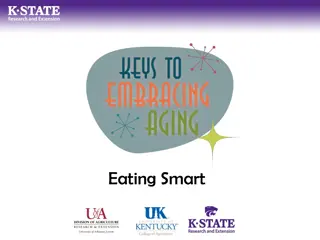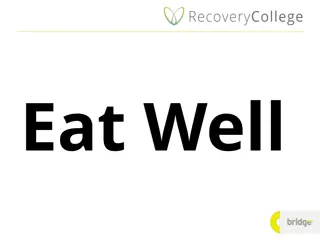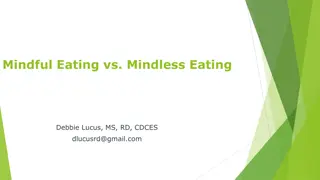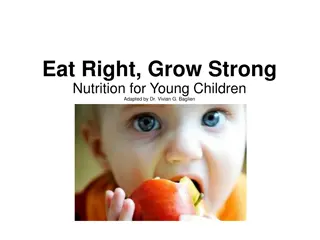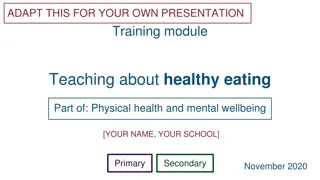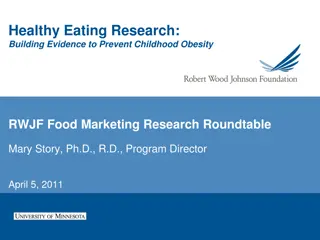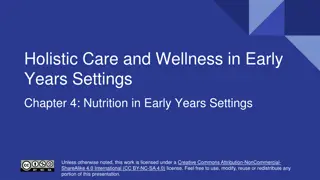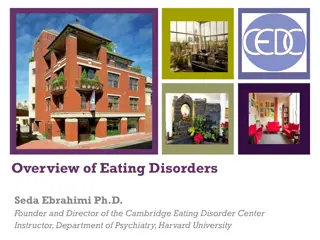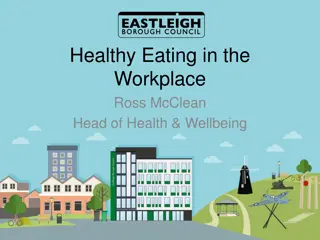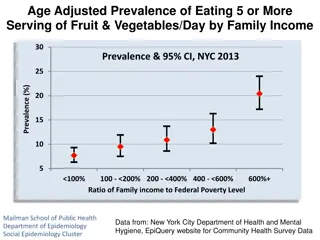Teenage Nutrition and Wellness: A Guide for Healthy Eating Habits
Teenagers aged 12-18 have unique nutritional requirements during a period of rapid growth and development. Consuming a healthy, balanced diet is crucial for their overall well-being, promoting mood, energy, reducing risks of future health problems, and enhancing cognitive abilities. It is recommended that teenagers focus on diverse food groups, including dairy, starchy foods, fruits, vegetables, and protein sources. Adequate intake of macronutrients and dietary fiber, along with micronutrient considerations, are essential elements for achieving optimal health in adolescents.
Download Presentation

Please find below an Image/Link to download the presentation.
The content on the website is provided AS IS for your information and personal use only. It may not be sold, licensed, or shared on other websites without obtaining consent from the author. Download presentation by click this link. If you encounter any issues during the download, it is possible that the publisher has removed the file from their server.
E N D
Presentation Transcript
Teenage Diets, Nutrition and Wellness As Adapted by Dr. Vivian G. Baglien
Teenagers (12-18 years)- Focus Areas Nutritional requirements Dietary recommendations Macronutrients Micronutrients Energy balance Physical activity Diet and cognitive ability Diet and behaviour Eating disorders Summary - key issues
Nutritional requirements Growth and development are rapid. Onset of puberty - characterised by a spurt in physical growth (height and weight). Considerable gain in muscle and bone mass. Changes in body composition, e.g. increased deposition of fat in girls. Energy and nutrient requirements at their highest.
A healthy diet is important for teenagers Eating a healthy, balanced diet can: promote wellbeing by improving mood, energy and self- esteem to help reduce anxiety and stress; boost concentration and performance; reduce the risk of ill-health now and in the future, e.g. obesity, heart disease, cancer, and type 2 diabetes; increase productivity/attainment and reduce days off sick.
Dietary recommendations Teenagers should consume a variety of foods from each of the four main food groups: Milk and dairy foods (15%) Bread, rice, potatoes, pasta and other starchy foods (33%) Fruit and vegetables (33%) Meat, fish, eggs, beans and other non-dairy sources of protein (12%)
Macronutrients - Average Intakes- http://drlisawatson.com/wp-content/uploads/2015/01/Macronutrient_Needs_Teens.jpg
What about dietary fibre? Dieticians found average dietary fiber intakes to be low in teenagers: - Boys (11-14 years) 11.6 g/day (15-18 years) 13.3 g/day - Girls (11 14 years) 10.2 g/day (15-18 years) 10.6 g/day Reference values: - 15 g/day (11-14 years) - 18 g/day (15 years or above)
Micronutrients - percentage of older children and teenagers with intakes below the RDI (Recommended Daily Intake) Vitamin Boys 11-14 yrs 8% Girls 11-14 yrs 20% Boys 15-18 yrs 13% Girls 15-18 yrs 12% Vitamin A Riboflavin (B2) 6% 22% 6% 21% Folate 1% 3% 0% 4%
Micronutrients - percentage of older children and teenagers with intakes below the LRNI Mineral Boys 11-14 yrs 3% Girls 11-14 yrs 44% Boys 15-18 yrs 3% Girls 15-18 yrs 48% Iron Calcium 13% 24% 9% 19% Magnesium 28% 51% 11% 53% Potassium 10% 19% 15% 38% Zinc 14% 37% 9% 10%
What about salt? Average salt intakes above recommendations in teenagers: - Boys (11-14 years) 6.75 g/day (15-18 years) 8.25 g/day - Girls (11-18 years) 5.75 g/day (excluding salt added in cooking or at the table) Recommended maximum daily salt intake: - 11 years and over: up to 6 g/day.
Teenagers and iron Teenagers have increased iron requirements. Girls need more iron than boys to replace menstrual losses (DRI: boys 11.3 g/day, girls 14.8 g/day). Low iron intakes (< DRI) in 44% of girls (11-14 years) and 48% of girls (15-18 years). 9% of girls (15-18 years) were found to have poor iron status Lack of iron leads to an increased risk of iron deficiency anaemia and associated health consequences. Teenagers who follow a vegetarian diet or restrict food intake (e.g. to lose weight) particularly at risk.
Iron absorption Good sources: meat (especially lean red meat), liver and offal, green leafy vegetables, pulses (beans, lentils), dried fruit, nuts and seeds, bread and fortified breakfast cereals. Iron from meat sources is readily absorbed by the body. Vitamin C helps the body to absorb iron from other sources.
Teenagers and calcium Teenagers have high calcium requirements. Around 50% of the adult skeleton is formed during the teenage years (RDI - boys 1000 mg/day, girls 800 mg/day). Low calcium intakes (< RDI) found in 24% of 11- 14 year-old girls and 19% of 15-18 year-old girls. A lack of calcium may have consequences for future bone health e.g. increased risk of osteoporosis.
Teenagers and energy balance Levels of overweight and obesity are increasing: 35% of teenagers (12-15 years) are classified as overweight or obese. Teenagers, especially girls, often try to control their weight by adopting very low energy diets or smoking. Restricted diets may lead to nutrient deficiencies and other health consequences. Teenagers of unhealthy weight may need guidance on lifestyle changes to help them achieve a healthy weight.
Teenagers physical activity Physical activity through life is important for maintaining energy balance and overall health. At least 60 mins of moderate-intensity physical activity each day is recommended. Include activities that improve bone health, muscle strength and flexibility at least twice per week. 68% of boys and 41% of girls (13-15 year-olds)
Diet and cognitive ability Food eaten at school can make up a substantial proportion of the diet and have a significant effect on functions such as learning, memory, information processing and mood. Cognition represents a complex multidimensional set of abilities and cognitive performance is affected by many influencing factors. Nutritional effects are difficult to measure. brain
Glycaemia The brain appears to be sensitive to short-term fluctuations of glucose supply and therefore it might be beneficial to maintain glycaemia at adequate levels to optimise cognition. think_smart
Eating breakfast Starting each day with breakfast will supply energy to the brain & body. Eating breakfast leads to improved energy and concentration levels throughout the morning. Breakfast consumption may improve cognitive function related to performance in school. Other benefits of breakfast include better nutrient intakes and weight control.
Fluids and hydration Even mild dehydration (1-2%) can lead to headaches, irritability and loss of concentration. This level is not enough to cause feelings of thirst. The recommendation is to drink 6-8 glasses/day (1.2 litres) to prevent dehydration. People need to drink more when the weather is hot or when they have been active. All drinks count in terms of fluid intake but those without sugar are best between meals.
Diet and IQ Brain health depends on optimal intakes of nutrients from the diet. Much speculation about the importance of long chain omega-3 fatty acids to behavioural and cognitive development, including IQ. Supplementation studies show the best outcome observed in children with learning disabilities. Current recommendation is one portion of oily fish (140g) per week.
Diet and mood/behaviour There are a number of foods that have a pharmacological effect in the body which affects mood: * caffeine; * vaso-active amines, such as histamine; * tryptophan and serotonin. There is evidence to suggest that poor vitamin and mineral status may be associated with poor educational attainment and antisocial behaviour.
Food additives and hyperactivity The Southampton study suggested that consumption of mixes of certain artificial food colours and the preservative sodium benzoate could be linked to increased hyperactivity in some children. The colours are: sunset yellow FCF (E110) quinoline yellow (E104) carmoisine (E122) allura red (E129) tartrazine (E102) ponceau 4R (E124) Bateman B et al. 2007 An EU-wide mandatory warning must be put on any food and drink (except drinks with more than 1.2% alcohol) that contains any of the six colours.
Teenagers - key issues Nutritional requirements Dietary recommendations Macronutrients Micronutrients Energy balance Physical activity Diet and cognitive ability Diet and behaviour Eating disorders
Teenagers - dietary improvements needed More fruit and vegetables, pulses, wholegrain foods. More milk and diary foods. More iron-rich foods. More oily fish. Less foods high in saturated fat and added sugars. Less salt.


